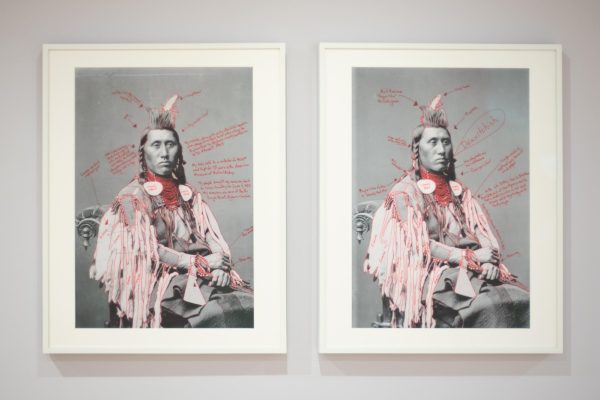As visitors exit the elevator on the third floor of the Whitney Museum of American Art, they might overlook the gallery waiting before them. But for those who enter and take a closer look, “What It Becomes” will leave them captivated by the process of how art comes to be.
“What It Becomes” features 18 pieces, including illustrations, photographs and film. Whitney Curatorial Fellow Scout Hutchinson organized the exhibition, which highlights lesser-known works from artists like Toyin Ojih Odutola, Ana Mendieta and Maren Hassinger. It also includes work by photographer Catherine Opie and Native American artist Wendy Red Star. While viewers only see the final product, “What It Becomes” offers a moving glimpse into the artistic journey.
The viewer is immediately drawn to the gallery’s main wall with Jim Hodges’ unconventional 1992 piece, “Untitled.” Purple splotches lay against a white background, created using Hodges’ saliva. The work is abstract, confusing and even uncomfortable. Without any extensive explanation next to the art, viewers are left wondering the significance, if any, behind Hodges’ use of saliva. The eccentric piece immediately pushes viewers to ponder his process, serving as a perfect centerpiece to the exhibition.

Hassinger’s film, “Daily Mask,” is displayed on a vintage television in a corner of the exhibition. The film features Hassinger, a Black artist, using a black grease crayon as face paint, gradually covering her entire face to reflect on “the history of blackface and the act of applying makeup,” as noted on the film’s label. If the piece was simply a photograph of Hassinger’s painted face, viewers could miss its powerful message. By recording her process, Hassinger’s piece beautifully embodies the exhibition’s thesis, presenting the act of creation rather than just the final product.
With many pieces in the exhibition, the artistic process seems to represent the artist’s larger personal journey. “Déaxitchish/Pretty Eagle” by Red Star consists of two inkjet prints showcasing photographs of an unidentified Apsáalooke sitter. Red Star used red ink to outline and annotate the pieces, highlighting Apsáalooke objects and clothing. Through her research into Apsáaalooke culture when making the piece, Red Star connected back to her heritage. Not only is the piece visually striking, it also eloquently represents Red Star’s personal journey with her identity.

Opie’s 1993 work “Self-Portrait/Cutting” is displayed on the main wall near Hodges’ piece. The chromogenic print depicts Opie’s bare back, carved with two stick figures holding hands, a house and a cloud. The carving is still in the process of scabbing over and remains partially bloody, setting a gruesome tone. The piece’s label nods to Opie’s pain as a queer person. By permanently cementing the pain associated with her sexuality on her back, Opie poignantly transforms and reclaims her suffering as art — a powerful moment of personal growth. The piece is unsettling, but its inclusion in the exhibition demonstrates how pain can transform into beauty.

The exhibition encourages viewers to pay attention and respect to the process of creating art. Not only does “What It Becomes” masterfully provoke curiosity, but it also elicits an emotional response from the deeply personal works.
“What It Becomes” is on display at the Whitney Museum of American Art through Jan. 12. Admission is free for NYU students.
Contact Skylar Boilard at [email protected].
